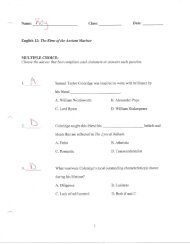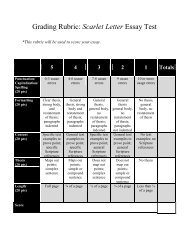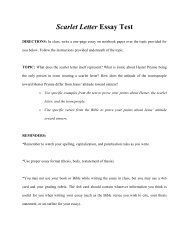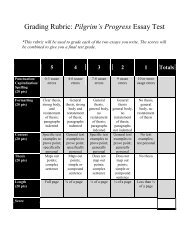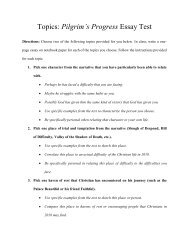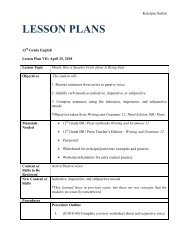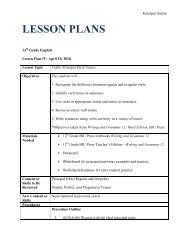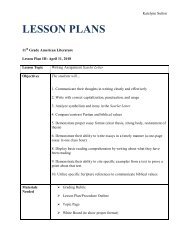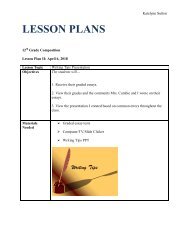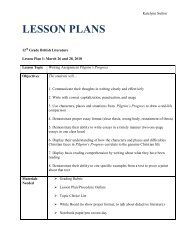22 Active & Passive Voice Sentences - Lesson Plan PDF
Create successful ePaper yourself
Turn your PDF publications into a flip-book with our unique Google optimized e-Paper software.
Katelynn Sutton<br />
LESSON PLANS<br />
12 th Grade English<br />
<strong>Lesson</strong> <strong>Plan</strong> VI: April 24, 2018<br />
<strong>Lesson</strong> Topic<br />
Objectives<br />
<strong>Active</strong>/<strong>Passive</strong> <strong>Voice</strong> <strong>Sentences</strong><br />
The students will…<br />
1. Distinguish between active and passive voice<br />
2. Identify retained objects and subjective complements<br />
3. Rewrite sentences from passive to active voice<br />
*Objectives taken from Writing and Grammar 12, Third Edition, BJU Press<br />
Materials<br />
Needed<br />
‣ 12 th Grade BJU Press textbooks Writing and Grammar 12<br />
‣ 12 th Grade BJU Press Teacher’s Edition—Writing and Grammar 12<br />
‣ Pen/pencil<br />
‣ Whiteboard for principal part/tense ex<strong>amp</strong>les and practice<br />
‣ Worksheets/handouts for extra student practice<br />
Content or<br />
Skills to Be<br />
Reviewed<br />
New Content or<br />
Skills<br />
Procedures<br />
Difference between active and passive voice sentences<br />
Retained objects<br />
Subjective complements<br />
Procedure Outline<br />
I. (8:30-8:35) Ask the class the difference between active and passive<br />
voice verbs.<br />
A. How can they be identified quickly?
Katelynn Sutton<br />
B. Which one normally has a direct object?<br />
C. Both are usually transitive verbs<br />
II.<br />
(8:35-8:40) Explain the difference between the two<br />
A. <strong>Active</strong>: subject is doing the action / subject is something<br />
1. More direct / emphasizes doer of the action<br />
2. More effective and desirable<br />
B. <strong>Passive</strong>: action is being done to subject / “be” verb plus<br />
second principal part<br />
1. Can be useful for special emphasis<br />
2. More effective and desirable<br />
III.<br />
(8:40-8:55) Revising active/passive sentences<br />
A. To switch from active to passive:<br />
1. Make DO the subject<br />
2. Add “be” verb<br />
3. Tack subject to the end if necessary<br />
B. To switch from active to passive:<br />
1. Take subject from prep. phrase or supply subject<br />
2. Make subject DO<br />
3. Take out “be” verb<br />
4. Make TrV active in form<br />
C. When the active sentence has an IO, the DO becomes a<br />
retained object in the passive sentence. (It could also be put<br />
into a prep. phrase to avoid confusion.)<br />
D. When the active voice sentence has an OC, the OC becomes a<br />
subjective complement in the passive sentence.
Katelynn Sutton<br />
IV. Complete practice exercise 7.6<br />
A. Underline complete verb of the sentence / identify its voice /<br />
underline ROs or SCs twice<br />
B. Check answers together as a class<br />
V. (8:55-9:10) Complete practice worksheet<br />
Key Questions<br />
A. Identify passive voice verbs, retained objects, and subjective<br />
complements in the paragraph<br />
B. Rewrite sentences containing any of the above in active voice<br />
C. Check answers together as a class<br />
(1) What sentences show the subject doing the action?<br />
(2) In which sentences is the action being done to the subject?<br />
(3) Which type of voice is more powerful in your writing?<br />
(4) Which type of voice is more useful for special emphasis in your writing?<br />
Activities<br />
‣ Lecture on active and passive voice and revising each type<br />
‣ Practice exercises<br />
‣ Practice worksheet<br />
Summary or Conclusion<br />
Review active and passive voice. Remind students that active voice is much<br />
more effective in writing. <strong>Passive</strong> voice should be used for special emphasis.



